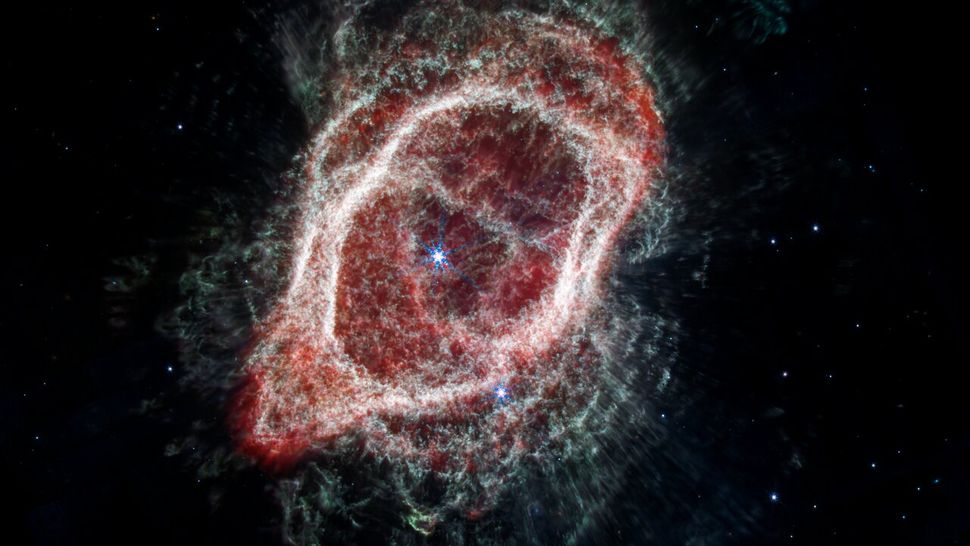Science
Related: About this forumScientists reveal Southern Ring Nebula's unexpected structure: 'We were amazed'
By Keith Cooper published yesterday
Submillimeter wavelength radio observations of the Southern Ring Nebula have identified that it's actually a double ring, shaped by the interactions of three stars.

a small bright blue point in the center is surrounded by exploding gas, hued red then diminishing to green before fading into the black of space. A composite near- and mid-infrared JWST image of the Southern Ring Nebula. (Image credit: NASA/ESA/CSA/STScI/O. De Marco (Macquarie University)/J. DePasquale (STScI))
The glorious, billowing Southern Ring Nebula is the cocoon of a dying star — and it has a secret. Scientists have found this nebula to exhibit a double-ring structure that evidences not one, but possibly three stars at its heart.
The Southern Ring Nebula, also designated NGC 3132, is a planetary nebula located about 2,000 light-years away in the constellation of Vela, the Sails. The name "planetary nebula" is a misnomer — such nebulas have nothing to do with planets. Instead, they are the final exhalations of dying, sun-like stars, which transform inside the nebulous chrysalis until finally blossoming into a white dwarf. A nebula is formed from the dying star's outer envelope, which is puffed off into space following the star's red giant phase.
The Southern Ring Nebula was imaged in December 2022 by the James Webb Space Telescope (JWST), which revealed molecular hydrogen gas forming the nebula's "exoskeleton." This refers to warm gas radiating with a temperature equal to about 1,000 kelvin (1,340 degrees Fahrenheit, or 726 degrees Celsius) as it gets illuminated and heated by ultraviolet light coming from the white dwarf itself. That exoskeleton, however, only represents a small fraction of the molecular gas in the nebula.
A team led by Joel Kastner of the Rochester Institute of Technology went hunting for more of the nebula's molecular gas, specifically searching for carbon monoxide gas using the Submillimeter Array (SMA), which is a group of eight radio telescopes on an inactive volcano named Mauna Kea in Hawaii. Carbon monoxide is mixed in with hydrogen and other molecular gases inside the nebula, so observing the carbon monoxide content is actually a proxy for observing all those other molecules that are not as easy to detect. Sure enough, the SMA was able to measure both the distribution and velocities of the carbon monoxide molecules, showing which parts are moving towards us and which are moving away from us.
More:
https://www.space.com/southern-nebula-exoskeleton-double-ring
Permanut
(6,641 posts)2,000 light years is just down the street on the scale of the universe.
Bernardo de La Paz
(50,922 posts)Bernardo de La Paz
(50,922 posts)The word and phrase "planet" and "planetary nebula" derive from the same root as "plane" and "plan". It would be a misnomer if "planetary nebula" derived from "planet", but it does not.
Planets travel quite close to a single plane around each star, including this solar system. Planetary nebula as we see them are basically rings, hence close to a single plane. But the nebula does not orbit, at least not the same way planets do. And they are larger than planet orbits.
The writers of these pieces frequently find themselves explaining the difference between them. It must be a relatively common misconception (easy enough) running around out there, or perhaps there are a lot of incidental low info readers of such articles.